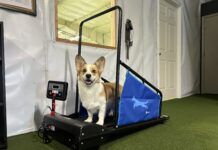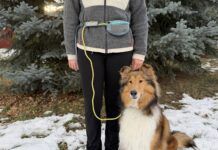Do you have a dog recovering from orthopedic or neurologic surgery, one who has mobility issues, or a senior dog who has arthritis? If so, at some point, you have probably wished you could do something – anything! – to help make your dog’s life (and your own) a little easier.
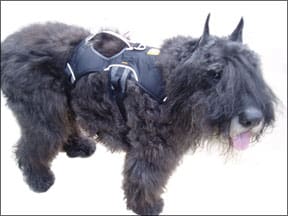
As someone who has shared her life recently with two large breed, geriatric dogs, I can attest firsthand that having a little bit of help can make all the difference in the world. Axel, our 85 lb. Bouvier, in particular, needed assistance toward the end of his life with getting up from lying down, being lightly supported during toileting, and occasionally steadied while walking. We used a few of the products listed below and found that they helped him maintain a good quality of life, mobility, and independence while lessening the physical strain on us.
I asked two veterinarians who specialize in canine rehabilitation to share some of their top picks for canine assistive/rehabilitative equipment. Laurie McCauley, DVM, CCRT, is founder and medical director of TOPS Veterinary Rehabilitation in Grayslake, Illinois, and is considered one of the pioneers in the field of veterinary rehabilitation. Evelyn Orenbuch, DVM, CAVCA, CCRT, recently opened Georgia Veterinary Rehabilitation, Fitness and Pain Management in Marietta, Georgia, and has focused on veterinary rehab medicine since 2003. (Full disclosure: I have worked with Dr. Orenbuch in my capacity as a marketing consultant during the launch of her new clinic.)
Photo courtesy Blue Dog Designs

Orthopedic Dog Harnesses
My favorite tool (and that of both veterinarians) is RuffWear’s Web Master™ Harness, described as a supportive, multi-use harness. Originally designed for dogs with active lifestyles (e.g., hiking, search and rescue), the harness has gained a big following with pet people looking for a way to give their dogs assistance in getting up and moving around, whether it be post-surgery or due to a degenerative or other medical condition. The harness features a well-placed, large handle, and is sturdy, machine-washable, and great for helping a dog up, or providing a steadying hand. The only downside is that the dog is required to lift a front paw to get into the harness. Suggested retail price: $50.

Offering more support is the Help ‘Em Up Harness from Blue Dog Designs. Both vets and I also give this product four paws up. The Help ‘Em Up is a complete shoulder and hip harness system, featuring two comfortable, rubber handles, one at the front and one at the back. The harness is well made, machine washable, and the front support is detachable from the back. To put the harness on, you don’t need to lift any of the dog’s limbs; I was even able to put it on my Bouvier, Axel, when he was lying down. Suggested retail price: $90 to $110.
Both the Web Master and Help ‘Em Up are comfortable enough for the dog to wear throughout the day in the house.
Orthopedic Foot Wear for Dogs
For dogs who have difficulty navigating slippery floors, Dr. McCauley likes Show Foot™ Anti-Slip Spray by Bio-Groom. Show Foot can be sprayed directly on the bottom of the dog’s feet (pads), or, if the dog is sensitive to the spray sound, can be sprayed on a cotton ball and dabbed on. The spray makes the feet feel tacky so they are less likely to slide on indoor slick surfaces.

Having hardwood floors in our house, I tried this product with Axel and found some success. It did leave some smudges where he walked, but they were easily wiped up. Priced at about $10.
Particularly for outdoor use, but great for any dog needing extra traction indoors or out, Dr. McCauley recommends Thera-Paw boots by Thera-Paw. These boots are made of a comfortable, breathable, lightweight, washable neoprene material. They are unique in that they have a front opening, so they’re great for dogs who don’t like to put their feet into boots. The boots use a Velcro closure, and have a natural flex point.
Although suitable for indoor use, these boots are especially good for dogs who need help outside or who chew their feet. The boots are sold individually, which is a nice option if your dog needs only two. Suggested retail: $22.
Photo courtesy of Handicapped Pets
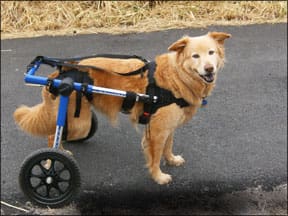
Mobility Devices for Dogs
For dogs who have limited hind end mobility and strength, Walkin’ Wheels offers a two-wheeled adjustable wheelchair that can be adapted as your dog’s needs change.
When a dog first requires a cart, he might be strong in the front end. But with time, or if he has a condition such as degenerative myelopathy, his front end can become weak, too. Dr. McCauley likes Walkin’ Wheels because the angle of the wheels, and therefore the cart’s balance point, can be changed to take the weight off of the dog’s front end, allowing longer ambulatory quality of life for him.
The company sells direct to consumers, and there are numerous instructional videos on fit and sizing on the company website. However, Dr. McCauley recommends that consumers work with their rehab veterinarian to get the correct fit. Walkin’ Wheels are priced from about $250 to $500.
For dogs who cannot put their full weight on their front limbs, but still have motor ability in their hind limbs, Dr. Orenbuch likes a four-wheeled cart, so that the dog can continue to engage his hind legs. A “quad cart” can give the dog support by transferring his weight to the wheels while allowing him to use his legs as much or as little as possible.
Photo courtesy Canine Icer

Putting a disabled dog into a cart does not have to signal the end, says Dr. Orenbuch. Depending on your pet’s condition, using a quad cart can actually speed the rehab process, allowing the dog to achieve greater mobility. She does not have a particular model that is a favorite. Talk with your dog’s rehab vet about whether your dog is a candidate for a quad cart.
Other Aids for Old or Injured Dogs
Dr. Orenbuch casts a vote for another Thera-Paw product, the Hind Limb Dorsi-Flex Assist. These light-weight custom braces provide support and stability for weak or dragging rear paws. Dr. Orenbuch likes them for dogs who have neurologic deficits such as degenerative myelopathy or disc disease, and whose rear toes knuckle, or turn under, as a result.
This product allows those dogs to walk nearly normally and have been used on dogs ranging from a 2-lb. Chihuahua to a 220-lb. Bull Mastiff. She cautions that they are not, carte blanche, for any dog with these conditions, and should be prescribed and fitted by your rehab veterinarian. They generally retail for $75 and up; this is typically a custom-ordered and custom-made product.
Photo courtesy Thera-Paw
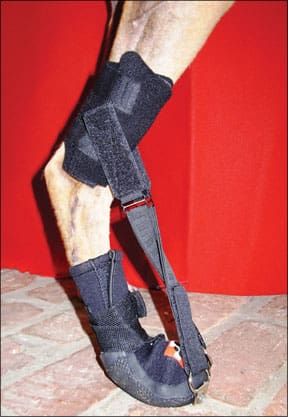
Many older dogs have chronically overused or injured their wrists, resulting in arthritis. For those dogs, or others who have wrist pain or have stretched the ligaments that stabilize the wrist, Dr. McCauley recommends Canine Icer Carpal Wraps. Many people don’t realize that sore wrists are a problem for their dogs. How can you tell? If your dog has his shoulder and elbow bent, when you bend his wrist downward, his toes should be able to touch his forearm. If this motion is uncomfortable, or if he tightens his muscles or pulls away, then Carpal Wraps can help.
Carpal support is also good for dogs whose wrist joints bend the “wrong way” when they’re standing. These dogs have hyperextension, and carpal support can help slow the progression of arthritis and the accompanying discomfort. Dr. McCauley likes the Carpal Wraps because they do not stop the dog from using the wrist (immobilization makes the joint weaker) but work by preventing the wrist from hyper-extending (which is what causes pain). She recommends dogs wear them on walks or when playing or running around. Suggested retail price: $21 (each).
Lisa Rodier is a frequent contributor to WDJ. She recently assisted in the launch of the Georgia Veterinary Rehabilitation, Fitness, and Pain Management facility. She shares her home with her husband and senior Bouvier, Jolie.




